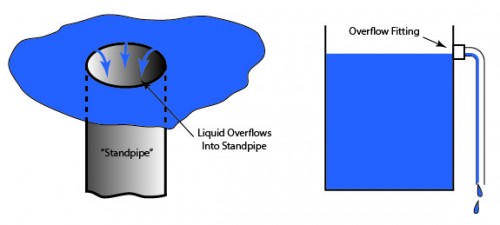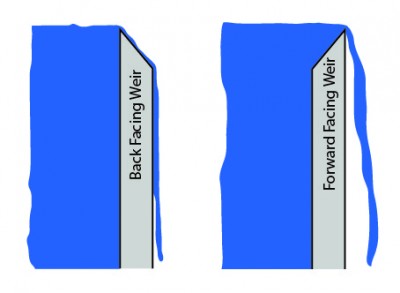Overflow weirs have specific purposes as they are utilized in industrial cleaning equipment. Also, as one might expect, there are several manifestations of the overflow weir which perform various functions. A simple “standpipe” is a form of weir as is a fitting on the side of a tank located just below the desired liquid level. An overflow fitting is generally placed on the side of the tank so that the bottom of the fitting is just below the desired liquid level.

In designing a weir, it is important to first recognize that the amount of liquid flowing over a weir, provided that the overflow depth remains constant, is directly proportional to the width of the weir. Wider weirs are required when it is necessary to accommodate a large volume of flow without a significant change in overflow depth. A 1″ diameter standpipe provides a weir approximately 3.14″ (C=πD) in width (the edge of the pipe circumference). The flow in the case of a standpipe is also limited by the capacity of liquid to flow down the pipe due to the force of gravity. In the case of a fitting mounted on the side of a tank, the calculation becomes a little more complex as the width of the “weir” changes as the level of liquid changes. Ultimately, however, the flow rate is still limited by the ability of liquid to flow through the outlet pipe. Standpipes or sidewall fittings are only applicable in cases where a relatively small flow of liquid is anticipated. In the case of an “emergency” overflow, weirs of this type should be designed to accommodate the maximum anticipated flow without the overall level in the tank reaching the top edge of the tank. Larger flow rates require wider weirs, eg. the entire width of one side of a process tank.
Weirs used for the main purpose of establishing and controlling liquid level generally don’t benefit from any particular lip consideration. In the case of surface skimming, however, lip design may be critical to achieve the desired effect.

It is generally felt that a knife edge weir or a weir sloped away from the overflow will give the best result in applications that involve skimming oil from a surface. When it comes to removing particles that float on a surface, however, a weir sloped toward the overflow is felt to provide superior results. A weir used to remove floating contaminants is generally used in conjunction with a sparger. The flow of the sparger moves particles toward the weir and also increases the flow over the weir. The sloped exit facilitates increasing flow velocity and the slight “lifting” required to help pushing particles over the edge of the weir.
Next, I’ll talk about some of the more unusual and sometimes weird features of weirs, their purpose and how they came to be. So, stayed tuned!
– FJF –



 English
English Spanish
Spanish Chinese
Chinese Canada
Canada Mexico
Mexico United Kingdom
United Kingdom



